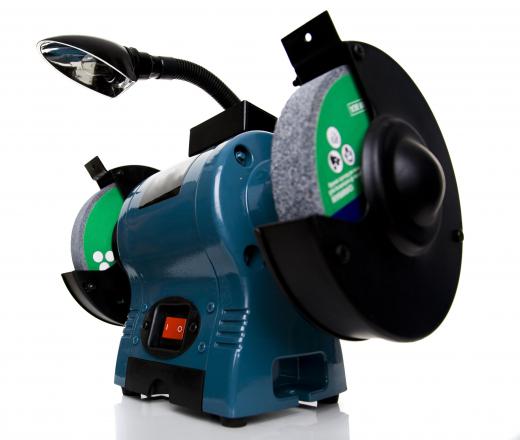A grinding machine is a tool that is generally used to shape and sharpen metal or metallic workshop equipment. A bench grinder, often called a pedestal grinder, is a rather simple type of this machine that is attached to a bench, which can be raised to the appropriate working height. It usually has two grinding wheels, each typically a different size. There is also usually a toolrest in front of each wheel on a bench grinder, which can typically be adjusted and set to create more consistent bevels.
There are various designs of bench grinders. Some are made for large shops, and others are designed to accommodate only smaller businesses. Although a bench grinder is generally a shop tool, there are some designed for home use. These can be used to sharpen non-workshop items such as scissors, garden shears, and lawnmower blades.

The two wheels tend to have different grain sizes so that a variety of jobs can be performed with a single machine. Some bench grinders, for example, are sold with a 36 grit wheel and a 60 grit wheel. The 36 grit wheel is course and usually used for stock removal. The 60 grit wheel, which is finer, is good for touching up tools, although it is not good for honing them.
These machines are not normally designed for precision grinding. The outcome is usually coarse, even when a wheel is considered to be for fine grinding. Depending on the job, further grinding may be necessary with a different type of grinding machine.
There are typically a variety of wheel sizes available. They can also be made out of different materials. The white wheels that are sometimes found on bench grinders are typically made of aluminum oxide. This material renews itself as it is being used. It has a reduced chance of overheating and clogs less frequently. The disadvantage, however, is that aluminum oxide wheels must be replaced more often.
Bench grinder features vary from one brand to another. Some models are smoother and quieter than others. Some will have adjustable motors so that the machine’s pace can be reduced to prevent overheating. Others have water trays so that the item that needs grinding can be cooled as the user is working.
A bench grinder’s accessories will also vary from one machine to another. Some have angled V-groove toolrests to allow for grinding of drill bits. Lamps are another accessory that users may find useful. There are models with a single lamp on top of the machine. There are also models with a lamp above each toolrest.
